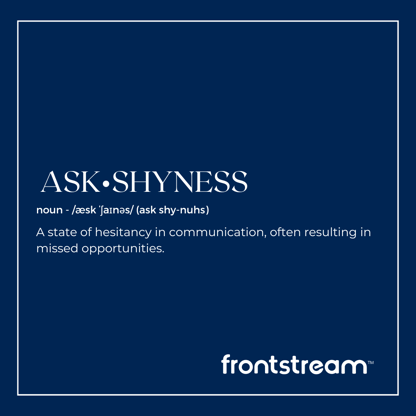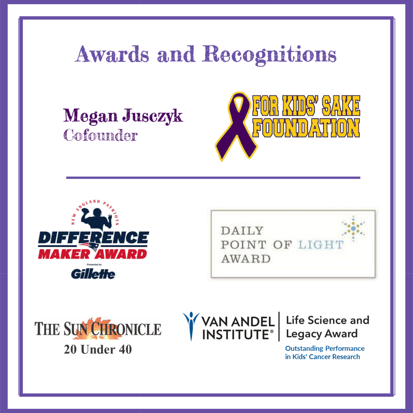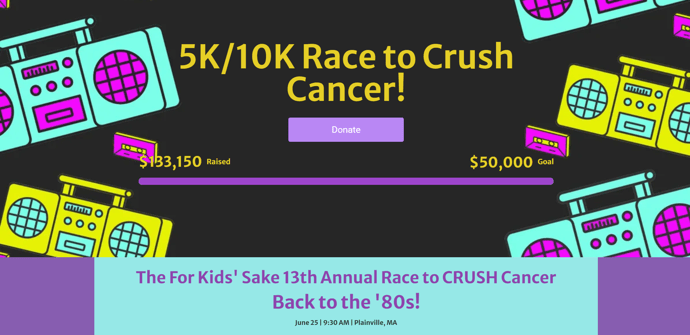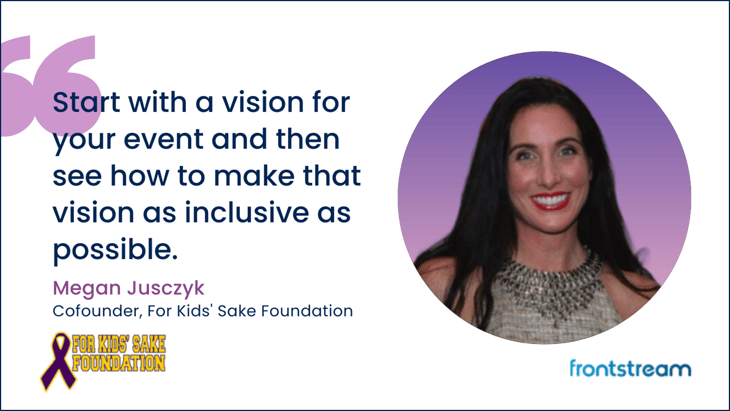Ask Shyness. Ask Discomfort. Whatever you decide to call that uneasy feeling, let’s face it: asking for money—even for a worthy cause—makes a lot of us uncomfortable. This type of hesitancy has the potential to throw a wrench in what could otherwise be a thriving peer-to-peer fundraising event since the success of your event is closely tied to the ability of your team fundraisers to overcome their discomfort with asking for donations.
Fortunately, we sat down with peer-to-peer aficionado Megan Jusczyk for a live discussion about ways to help your team fundraisers banish ask shyness once and for all. The hour-long talk was packed with helpful tips, so we created this “cheat sheet” of main takeaways for everyone to carry with them into peer-to-peer event season!

Back up a little: What exactly is peer-to-peer fundraising?
Peer-to-peer fundraising involves teams and individuals raising funds for your nonprofit by reaching out to their personal network of friends, family, and colleagues. By creating a personal fundraising page or team page on a fundraising platform and sharing it through social media, email, and other channels, individuals can attract a lot of donations that collectively add up to a significant amount of funds.
Peer-to-peer-style fundraising events are a fantastic way to expand your reach beyond your existing donor base and build a sense of community around your cause. Peer-to-peer fundraising has become increasingly popular and proven effective in raising funds, whether your cause is centered on health, education, environmentalism, religion, racial or gender equity, animal welfare, or anything in between.
About Team Fundraising Expert, Megan Jusczyk
Megan Jusczyk—the guest speaker at our Say Goodbye to “Ask” Shyness: Keys to Unstoppable Team Fundraising discussion—cofounded the For Kids’ Sake Foundation when she first recognized how little funding goes to both childhood cancer research and families in need of financial assistance after a pediatric cancer diagnosis turns their lives upside down. 
Over the last decade, For Kids’ Sake has hosted over 50 peer-to-peer events—everything from triathlons and soccer tournaments to annual 5k/10k races and golf tournaments! The foundation has also supported a multitude of DIY-style fundraisers that their supporters have hosted to raise funds on their behalf over the years.
As Megan mentioned during our Goodbye, Ask Shyness discussion: For Kids’ Sake has experience running all sorts of fundraising events, from galas to hybrid auctions and raffles. But peer-to-peer events are her favorite. They “hold a special place in [Megan’s] heart,” as they not only get entire communities working together, but they also bring in a ton of funds for your cause.
And Megan takes peer-to-peer fundraising seriously. Ensuring that her team fundraisers feel confident and passionate in their donation requests brings her a giant step closer to helping save more kids’ lives. She has passionately and tirelessly thought about ways to put ask shyness in the rearview, and these tips that she shared during the live discussion are easy for any nonprofit team to apply to their peer-to-peer fundraising strategies.
Megan’s Top Tips to Help Your Team Fundraisers Overcome Ask Shyness
Nail Down Your Narrative
Stories pull people in. And everyone who works for a nonprofit has a valuable, personal story about why that cause is so important.
People connect to emotional storytelling and are more likely to positively respond to a call to action because of a clearly laid out, emotionally charged appeal than they are to disconnected stacks of statistics and numbers.
Don’t get me wrong, statistics have their place, but you want to cushion them with a healthy dose of an emotional appeal for maximum impact as you connect with team fundraisers and give them the tools to connect with donors.
Key Points to Keep in Mind When Forming Your Narrative
- Identify the key elements of your story: Start by pinpointing the problem your organization is trying to solve, the impact you're making, and the people you're helping.
- Craft a compelling narrative: Use those key elements to create an authentic and emotional story that resonates with your audience.
- Use data and facts to support your narrative: Back up your claims with statistics, case studies, and other evidence that demonstrate the impact your organization is having.
- Incorporate visuals: Use photos, videos, and other visual aids to help your story come to life and engage your audience.
- Make your audience the hero: Position your audience as the hero of the story and show them how their support can make a real difference.
- Connect on a personal level: Use relatable language and avoid technical jargon to connect with your audience on a personal level.
- Call to action: End your story with a clear call to action, encouraging your audience to donate, volunteer, or take some other action to support your nonprofit's mission.
Here’s an example of a time Megan paired up with another nonprofit called Beat Childhood Cancer to help promote one of their campaigns. This video clearly demonstrates all the suggestions I listed above and can be a useful guide as you work on perfecting your own narrative.
Break Down Barriers with the Right Peer-to-peer Fundraising Software
Megan said that many years ago she was at a peer-to-peer event and was blown away by how successful another childhood cancer nonprofit was at raising funds compared to For Kids’ Sake at that time, so she contacted them to ask, “What’s your secret?”
When they told Megan about FirstGiving—now part of FrontStream’s all-in-one fundraising platform—she immediately did her research and then adopted the platform to bring For Kids’ Sake’s peer-to-peer game to the next level.
Megan says that an unfathomable portion of For Kids’ Sake’s fundraising success—and going from raising only a few thousand dollars per event to nearly $3 MILLION overall throughout recent years—is directly due to implementing FrontStream’s powerful yet super intuitive fundraising technology to run more events and raise more funds.
Not only that, but by using peer-to-peer fundraising technology, she gives her team fundraisers a vital tool that makes their donation ask so much simpler. When your team supporters can “show” potential donors more than “tell” them about an event or the structure of an event, they feel way more empowered to deliver their ask and exceed their goals.
Here are key points Megan brought up about how peer-to-peer software is a gamechanger for nonprofits interested in maintaining and reaching new support year after year:
Develop Dynamic Event Pages
You can easily put together beautifully branded event pages that include everything you need to promote your event and collect registration fees and donations all in one spot. This comes in especially handy when you have event themes.
For example: For Kids’ Sake’s 13th Annual 5k/10K to Crush Cancer is ‘80s themed this year, so they want their event page to give bodacious ‘80s vibes throughout to get supporters in the festive mindset before they even arrive at the event!

*For Kids' Sake ultimately ended up raising 144% over their goal for this event
Create an Unlimited Number of Events at the Same Time
This is a HUGE one. You don’t want to limit your fundraising. You want to give supporters the chance to easily set up their own DIY-style campaigns on your behalf, even while you’re running as many bigger events as you’d like at the same time.
Megan told us a great story of how this offering helped For Kids’ Sake: One of their supporters (Steve!) ran his own DIY campaign and was happy with the idea of raising a couple of thousand dollars for For Kids’ Sake. He hosted a small event or two at his house (a pizza party, a cornhole tournament in his backyard, etc.).
By creating a customizable event page and linking it to QR codes placed on flyers around his yard and home, Steve raised over $15,000. With all donations processed directly through For Kids’ Sake's integrated payment system, the collection and attribution of funds to his campaign page were seamlessly efficient for both Steve and Megan’s organization.
Simplify the Ask Every Step of the Way
- Unlimited Promo Codes with expiration dates for team and individual supporters not only set a sense of urgency for registrants but also to add a nice, personalized touch that shows team fundraisers that you are thinking of them and count on their support year after year. Also, when your team fundraisers are trying to recruit people to register and join their teams, setting up promo codes for them to offer as a discount helps make the “ask” into a gift!
Two main ways For Kids’ Sake uses promo codes that you can try for your next event to bring in more funds:
-
- Offer extra gift incentives. People love a little something extra. A limited-time promo code for something like a t-shirt will get people registering a lot quicker and in higher numbers so as to not miss out on a deal.
Example: “If you register with a team or individual by [x] date, we’ll send you a free racing shirt! Remember to choose your shirt size during checkout.“
- Ensure repeated support. With an unlimited amount of promo codes, you can create special ones for different teams that tend to come out and fundraise for annual events year after year. In this instance, the promo codes work as a subtle yet powerful personalized call-to-action; you’re giving teams the chance to sign up with a discount and offer others who join their team the same discount, and this shows that you recognize the good they do, and how much you count on their support.
- Offer extra gift incentives. People love a little something extra. A limited-time promo code for something like a t-shirt will get people registering a lot quicker and in higher numbers so as to not miss out on a deal.
💡Remember: You always want to set an expiration date on all promo codes, as the fear of missing out on a good deal is the main motivator here.
- Share fun ideas that team motivators can use to bolster support. Speaking of “expiration dates” and deadlines, you can help team supporters reach their fundraising goals by sharing zany fundraising ideas for them to pick and choose from.
Example: “I’ll shave my hair into a mullet for the ‘80s 5k if [social media friends and family] donate to my team and help me reach my goal of $500 by [x] date!”
- In-app coaching is another wonderful feature that keeps team fundraisers engaged with dynamic tips and updates every step of the way to meeting their goals.
Lean into Clear, Concise Asks with Customizable Features
- Leaderboards show a team or individual’s fundraising goal and how much more they need to raise to achieve their goal in real-time. (It’s great to share screenshots on personal leaderboards on social media along with a link to their team’s fundraising page to promote the cause and implement a call to action.)
- Email templates help you personalize your outreach, so you can set reminders of upcoming discount/promo deadlines to segmented groups of donors and motivate teams to get into action.
- Get creative with QR codes to maximize outreach and ease the ask for your teams. Some of the many places For Kids’ Sake has enacted QR codes to up donation amounts over recent years:
-
- Mailings sent to supporters’ homes
- Flyers placed inside businesses (with business owners’ approval, of course)
- Promotion signs in front of businesses and individual supporters’ homes along sidewalks
- Flyers hung up at heavily trafficked areas, like ATMs, gas pumps, bus stops, and dog parks
- By restrooms, check-in tables, live auction sites, and refreshment stands at live events
- Event merchandise, like on the back of t-shirts
- Even on tax receipts that you send to all supporters after the event
- Peer-to-peer Event Add-ons give you the ability to easily incorporate auctions as part of your peer-to-peer festivities. As Megan pointed out: Not everyone is able to participate on a team during an event, and some people might not even want to simply donate to the cause or a team. But when you also have things like auctions included as part of the festivities, there’s a great chance a subsection of folks will be interested in partaking that way...and this leads me to another key way Megan says you can make the ask easier for your peer-to-peer participants...
Consider the Inclusivity of Your Peer-to-peer Event
The more people your event appeals to, the easier it is for your team fundraisers to not only feel confident asking for more in donations but also in asking MORE people to support and join the cause!
For Kids’ Sake’s annual family-friendly 5k/10k race is a great example. Every summer, the organization secures a permit for a large park. They use it as the start line and finish line for the races. But the park also has a wooden pavilion over a bunch of picnic tables that they use for a silent auction + face-painting station for the kiddos. There’s a playground that grandparents can bring little ones to while other family members take part in the race. A gazebo for a sound system and for announcing awards for runners in every category. A soccer field where they set up a bouncy house for kids and have the local fire department create a foam party for everyone to play around and cool off in!
When you attempt to make your peer-to-peer event inclusive, more people are interested in attending. Even if a few attendees aren’t paying for/donating to every aspect of the event, they’re still incredibly valuable to your cause, as they play a vital role in getting the word out to others who may just be your next major fundraising superstar. Who knows—if they see a vacation package on the auction table they can’t resist bidding on, or they decide that they or their friends and family out-of-town would love a piece of branded merchandise commemorating the event—they might end up giving in a way that works best for them. (And with all-in-one fundraising software, their impromptu monetary support all goes to the same place, so it’s beneficial AND easy for all parties.)
Thank Absolutely Everyone (And Often!)
According to Megan, this is THE most important aspect of running peer-to-peer events, rivaled only by the fundraising software you adopt.
For business sponsors, team supporters, and donors alike, Megan always finds at least seven ways to show her appreciation for their support after every event.
A few ways showing gratitude helps you maintain and build your support base year after year:
- Strengthens relationships: By showing your gratitude and expressing your appreciation to your sponsors and donors, you create a positive impression and establish a positive relationship between your organization and your supporters. This can lead to continued support in the future!
- Demonstrates professionalism: Saying "thank you" is always polite, but it's also a sign of professionalism. By sending thank-you notes or other forms of acknowledgment, you show that your organization values and respects its supporters. This helps establish trust and sets a positive tone for future interactions.
- Increases the likelihood of continued support: Did you know that donors and sponsors are more likely to continue supporting your organization in the future when they feel appreciated? It's true! By expressing your gratitude, you can increase the likelihood of continued support, which can include making additional donations, attending future events, or even becoming a recurring donor.
- Enhances your organization's reputation: Finally, acknowledging your sponsors and donors publicly can help enhance your organization's reputation within the community. This can help attract new supporters and potential sponsors for future fundraising events, which can help you raise even more money for your cause.
A great example of one of the ways For Kids’ Sake combined a lot of Thanks into one call-out:
Megan's Final Words
After our live discussion, Megan texted me a list of points she wishes she made, and I thought this was a great place to share them. All is not lost!
- “The larger the variety of different ways that people ask for donations that you can highlight, the better. There’s a way that works for everyone when it comes to banishing ask shyness, and it’s our job to make sure we connect them with the solution that works best for them.”
- “Send an email within 48 hours of a participant signing up for your peer-to-peer event, asking them to:
-
- Set a fundraising goal (if they haven’t already) and let them know there’s no need to overthink it—because they can always change it—and just go with their gut
- Ask them to share on social media why the fundraiser/cause is personally important to them and then ask others to join their team and/or donate to them
- Tell them to thank everyone who donates, shares their posts, or comments
- Suggest they ask for donations/support by a certain date, and give three – five options for how they can do it
- Ask them to tag your organization or use your hashtag for the event so you can support their team, share their progress, and celebrate their success”
- “Encourage supporters to stay optimistic and to keep going until the finish line”
- “Make sure to celebrate effort, not just results. Some people are going to spread the word more than fundraise, and sometimes they’re the people who connect you to your biggest donors—so, make sure they feel appreciated and seen, too!”
- Always reflect with your team right after an event while it’s still fresh in your mind. What went well? What should we adopt or push further for the next event? What didn’t work so well? Etc. You want to grow and learn from both your mistakes and successes. The more you’re willing to grow, the better your events will be. And the better your events are, the easier it is for your supporters to want to get as many people involved as possible.”
Looking to Supercharge Your Peer-to-Peer Fundraising?
If you’re interested in ways to up your peer-to-peer game while simplifying the ask for your supporters, FrontStream’s all-in-one fundraising platform covers all your bases. To learn about all the ways we mentioned above (and way more, to be honest), contact us today!



